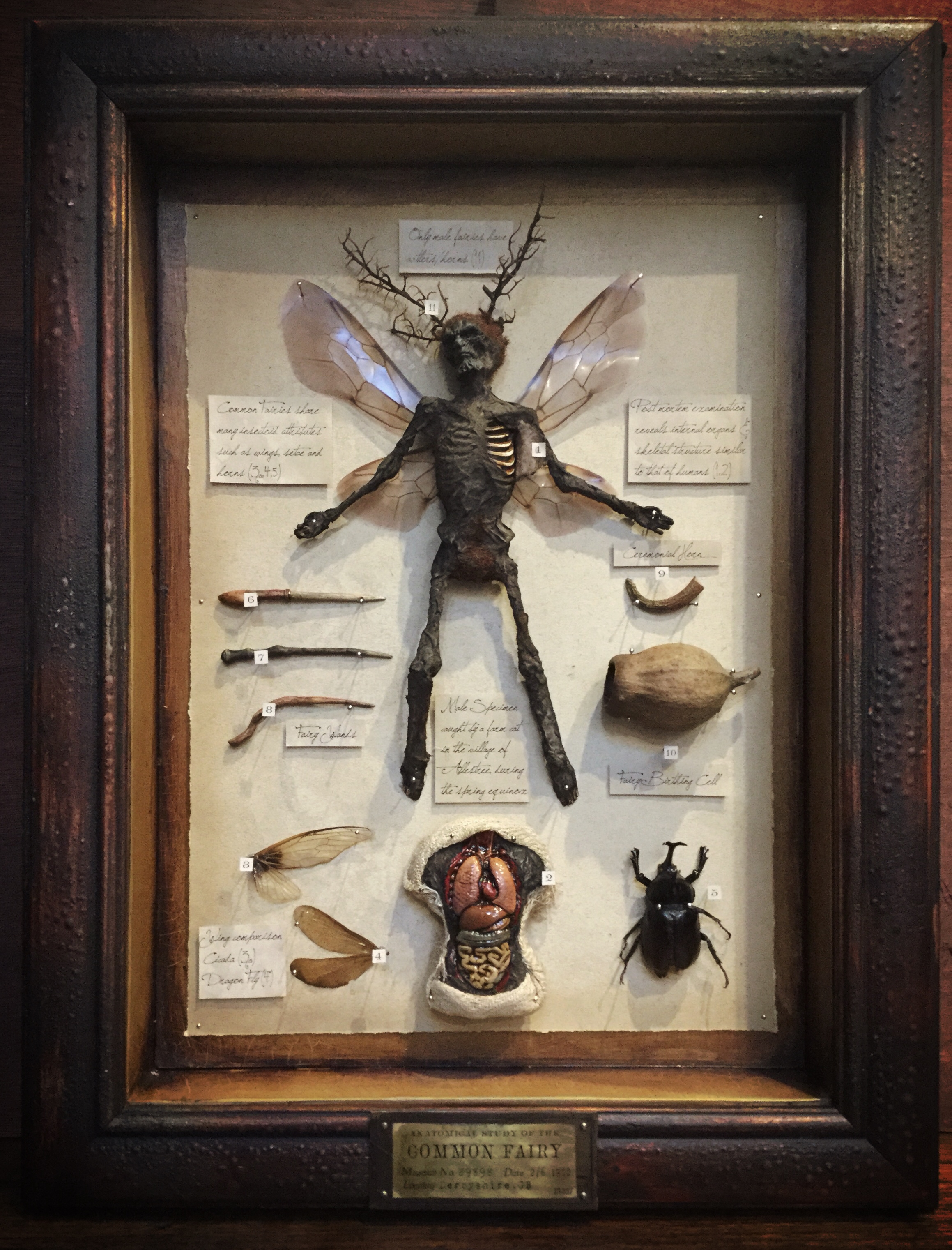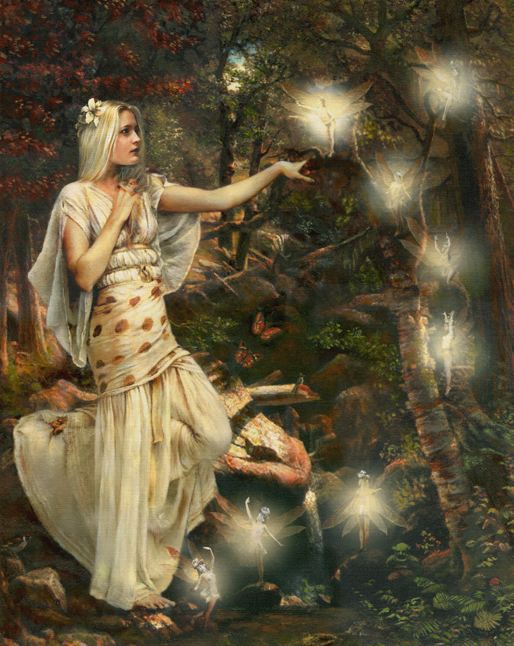Anatomical Study of the Common Fairy
From the private collection of Octavius Rookwood (August 16, 1853 – July 17, 1936), American British pharmaceutical entrepreneur, explorer and occult researcher.
This specimen was acquired by Rookwood during a stay with the Duke and Duchess of Devonshire at their home, Chatsworth House in Derbyshire, UK. A farmer from the village of Allestree, situated approximately 30 miles to the south of the Chatsworth estate, discovered the small fairy body when his faithful rat catcher left the limp remains on his kitchen floor. The cat normally left daily 'glory gifts' for the farmer which comprised of mice, rats and small birds but during the spring of 1902 it started to leave dead fairies. Rumours spread throughout the local villages and the farmer began to exhibit them at the pubs and cattle shows for a small fee. Rookwood got wind of the story and promised the farmer a handsome reward if he could supply him with a fresh specimen. The farmer promptly delivered two fairy corpses to Rookwood; one complete and another partially devoured by the farm cat.
The framed specimens were exhibited at the Royal Anthropological Institute in London for a number of years before disappearing in 1911. They were rediscovered in 1998 during the restoration of Rookwood's ancestral home by the National Trust. Dismissed as a late Victorian sideshow oddity, the fairies were auctioned at Sotheby's to raise funds for the upkeep of the estate and purchased by a private collector believed to be a prominent Canadian businessman.
The attempt to prove the existence of fairies
Here's an interesting article from OZY which discusses various scientific attempts to prove the existence of fairies and similar creatures. Most of the theories are flawed from the outset and are derived from bizarre ideas such as a race of pygmies living under Stonehenge! Enjoy...
They used to be normal. Stolen away into the jungle by evil wizards who cut out their tongues, the Asiki children were transformed, their woolly hair morphing into long, sleek locks. Witchcraft destroyed their memories, and the poor, cursed children wandered the streets on dark nights in search of their long-lost homes. Or so the story went.
But Dr. Robert H. Nassau wanted to set the record straight. An elderly Christian missionary stationed in Libreville, French Congo, in 1901, Nassau, who was spiritual but not superstitious, patiently explained to townsfolk that they had nothing to fear from this mythical race of “little people.”
He had no time for such nonsense and always tried to refocus the conversation back toward his brand of Christian scientific rationalism … that is, until one particularly dark, moonless evening. With the sky covered in thick clouds, Nassau went for a walk and noticed a strange little figure following him. Upon closer inspection, he saw how the figure had strange, long black hair and struggled with a tongueless mouth to respond to his queries. A man of science, the Frenchman chased after the small being in hopes of capturing it for examination. But the only thing he caught, according to his mission log, was a single snippet of strangly, silky hair.
This account is an example of the late-19th and early-20th century’s fascination with euhemerism, the attempt to prove the existence of fairies (and other myths) through science and anthropological study. Tales like Nassau’s thrilled Victorian and Edwardian audiences, whose interest in mythical people was ignited by a growing sense of nationalism and the rediscovery of Shakespeare, particularly the Bard’s enchanting fairy-driven romance, A Midsummer’s Night Dream. Nassau’s telling reflects an effort to try and reconcile turn-of-the-century fairyphilia with the climate of scientific rationalism that characterized the Industrial Revolution.
Some 19th-century euhemerists like Alfred C. Haddon, George Laurence Gomme and John Stuart Stuart-Glennie argued that fairy tales were creative retellings of racial clashes in Bronze Age Britain. Haddon believed, for example, that fairy tales could be read “as stories told by men of the Iron Age of events which happened to men of the Bronze Age in their conflicts with men of the Neolithic age.”
The most sensational of the 19th-century euhemerist theories was presented by Scottish writer David MacRitchie in The Testimony of Tradition (1890). In this study, MacRitchie argued that fairies were actually a pygmy race of ancient Britons who once lived in the underground tombs and passageways found around archaeological sites like Stonehenge. Georg Schweinfurth’s discovery of African pygmies in the 1870s supported MacRitchie’s hypothesis, and when in the course of colonial expansion, R.G. Haliburton found a race of dwarfs living in the Atlas Mountains of southern Morocco, his theories seemed irrefutable.
Today, we know MacRitchie’s theories were wrong: “Advances in … archaeology, linguistics, anthropology and so on have since demonstrated that euhemerism might have been intellectually attractive but was not historically true,” says Adam Grydehøj, lead editor of Island Studies Journal. We now know that “a race of pygmies did not inhabit Europe prior to the arrival of a hypothesized race of Aryans.”
This approach to euhemerism combined Charles Darwin’s sensational theory of evolution with folklore, creating a scientific theory of fairies as a forgotten humanoid race. But other euhemerists, like Englishman Robert Southey, linked the fairy myth to St. Patrick’s mythical expulsion of Ireland’s snakes. The story of St. Patrick is said to be an allegorical retelling of the conversion of the Irish from paganism to Christianity in the fifth century, with the snakes representing Druidic priests who were known to have serpents tattooed on their forearms. So this branch of euhemerism claimed that the Druids, fearing persecution from their Christian
Even well into the 20th century, fairy theories evolved to reflect scientific and technological advancements. The most famous example? None other than Sir Arthur Conan Doyle’s attempts to explain the famous Cottingley fairy photographs through electromagnetism. Taken by cousins Frances Griffiths and Elsie Wright of Yorkshire — they later admitted the photos were a hoax — these pictures depicted fairies with incandescent wings and stooped mischievous gnomes dancing and frolicking around the teenagers. “The Cottingley Fairies” consumed Conan Doyle’s imagination, prompting him to write a book in 1922 titled The Coming of the Fairies, based on his research and experiences with the girls.
Doyle theorized that fairies existed on a different vibrational spectrum, like X-rays or ultraviolet, and could be seen only by those who could “tune in to” their world. He also guessed that the reason Elsie and Frances’ fairies seemed two-dimensional was because fairies were made of pure light and cast no shadow. In reality, the fairies that baffled and enchanted a nation were nothing more than cut-out fairy-tale illustrations propped up by hat pins.
In a world rocked by dizzying techno-scientific discoveries, it seems that euhemerism and other fairy theories were a way for people in the 19th and early-20th centuries to reconnect with simpler times — ones filled with mystery and enchantment.
The Cottingley Fairies - A case study in how smart people lose control of the truth
This article by Rosa Lyster for Quartz discusses something I encountered when it was revealed that the mummified fairy images I produced were fake. Even once you unveil the truth, a significant percentage of people will choose not to believe it. My hoax had similar parallels to the Cottingley case; although I revealed the whole event to be hoax, I also publicly admitted my belief in fairies and that I had also seen them, a statement I stand by to this day.
The title of Rosa's article 'how smart people lose control of the truth' can be demonstrated even more with religion. It doesn't take fairies to show how people, even the smart ones, can believe in the most absurd things. Just look to the myths and legends purported by mainstream religion and you'll find a melting pot of unfeasible craziness where the control of the truth was lost thousands of years ago.
-
One hundred years ago, two girls went down to the stream at the bottom of a garden in Cottingley, England, and took some photographs of fairies. The fairies were paper cut-outs, which Elsie Wright, age 16, had copied from a children’s book. She and 10-year-old Frances Griffiths took turns posing with the sprites.
The girls developed the photographs in Elsie’s father’s darkroom, and presented them to their families as stunning evidence that fairies were real. Elsie’s father didn’t believe them—but her mother did. Two years later, she showed the photographs at a meeting of the Theosophical Society, a group dedicated to exploring unexplained phenomena and “forming the nucleus of a universal brotherhood of humanity.”
The story of the Cottingley fairies has always fascinated me—not because of the particulars of the case, but because of what it reveals about the life cycle of a lie. In contrast to other famous hoaxes, it doesn’t seem malicious, or even necessarily deliberate. Instead it seems to me to be a story about how a single, relatively small act of deception can lead a large group of people to lose control over the truth.
In the first photograph, Frances Griffiths stares somewhere to the right of the camera lens, pointedly not looking at the cardboard figures capering on the grass in front of her. In the second one, Elsie Wright leans forward to shake the hand of a toddler-sized boy fairy. Looking at them now, both photographs seem immediately identifiable as fakes. The figures are obviously propped-up and two dimensional. Everything, including the expressions on both girls’ faces, looks staged. It is hard to imagine the photos seeming convincing to anyone older than 12.
Yet the Theosophical Society saw things differently; the members immediately and ecstatically accepted the photographs as real. Edward Gardner, a writer and leading member of the Society, took them as proof that the “next cycle of evolution was underway” and mounted a campaign to convince the public of their authenticity. He gave lectures on the photographs, made copies of them, and passed them reverently around at meetings.
Initial press coverage was skeptical; one editorial noted that the photographs could be explained not by “a knowledge of occult phenomena but a knowledge of children.” But during and after World War I, spiritualism and mysticism gained increased influence over a grieving British public. The fairy photographs seemed to resonate with many people who were eager to believe in the existence of a better world, and in the possibility that we might be able to communicate with it.
Willingness to believe in the fairies was not a matter of intelligence or education. None other than Sir Arthur Conan Doyle, a trained physician and the creator of Sherlock Holmes, was dead-set on the whole notion. Doyle, a noted spiritualist, saw the photographs as evidence that communication could exists between material and spiritual worlds.
Doyle published an article about the photographs in The Strand magazine, and sent Gardner to visit the girls. Imagine being either Frances or Elsie at that moment. You have told a lie—a tale that started out as a joke, maybe, or a daydream. Now things are taking on a momentum that you cannot quite control. A stranger comes to your house with two cameras and says, No pressure, kids, but we would all just be thrilled to death if you could get us a few more shots of those fairies. Do you confess and make a fool out of everyone—or do you do what everyone clearly wants you to do, which is traipse off down to the stream and produce some more photographs?
The girls came back with three more pictures: Frances and the Leaping Fairy, Fairy Offering Posy of Harebells to Elsie, and Fairies and their Sun-Bath. These, too, look absurdly fake to modern eyes. But Gardner and Doyle fell for it again. Gardner then brought in a psychic, who claimed that the whole place was just crawling with fairies.
To me, the strangest part of this story is not that two girls pretended they knew some fairies, but rather that adults so badly wanted their encounters to be true. Not just Gardner and Doyle, whose reputations, by that point, were at least partially at stake. Lots of people were ready to believe. They twisted and massaged the narrative to add credibility. The social reformer Margaret Macmillan, for instance, emphasized that the photographers were children, and thus without motive or guile: “How wonderful that to these dear children such a wonderful gift has been vouchsafed.”
The novelist Henry de Vere Stacpool, meanwhile, insisted that the photographs were real because they just seemed truth-y: “Look at [Frances’] face. Look at [Elsie’s] face. There is an extraordinary thing called Truth which has 10 million faces and forms—it is God’s currency and the cleverest coiner or forger can’t imitate it.” The girls were telling the truth because they looked like they were telling the truth, and that was proof enough.
Eventually, people stopped caring about the fairies. Interest in the supernatural was on the wane, and Doyle was looking increasingly unhinged. The girls produced no more photographs, and the public moved on.
Every once in a while, though, someone would track down one of the girls and press them for more details, or try to get them to admit that they had been making it up. In 1983, they finally admitted that the photographs were faked, but maintained that they really had seen fairies. Elsie said that they were all faked, but Frances said that the last one was real. Frances’s daughter later insisted that fairies were real, and that her mother would never lie. You will still find corners of the internet today where people will say the same thing. Despite the girls mostly owning up to the lie, people still want to believe it, and so they will say that it is true.
The problem with telling a lie is that you often have to tell another one after that, to keep up appearances. And then it’s too late to admit what you made up, and so you just keep on lying. The issue becomes not the initial act of deception, but the fact that you’ve lied for so long—years and years and years. You may even start to believe the lie yourself. I have been thinking about it a lot lately, watching the news. Watching people on my TV lie; wondering if they even know that they are lying, as the stakes keep getting higher and higher.












